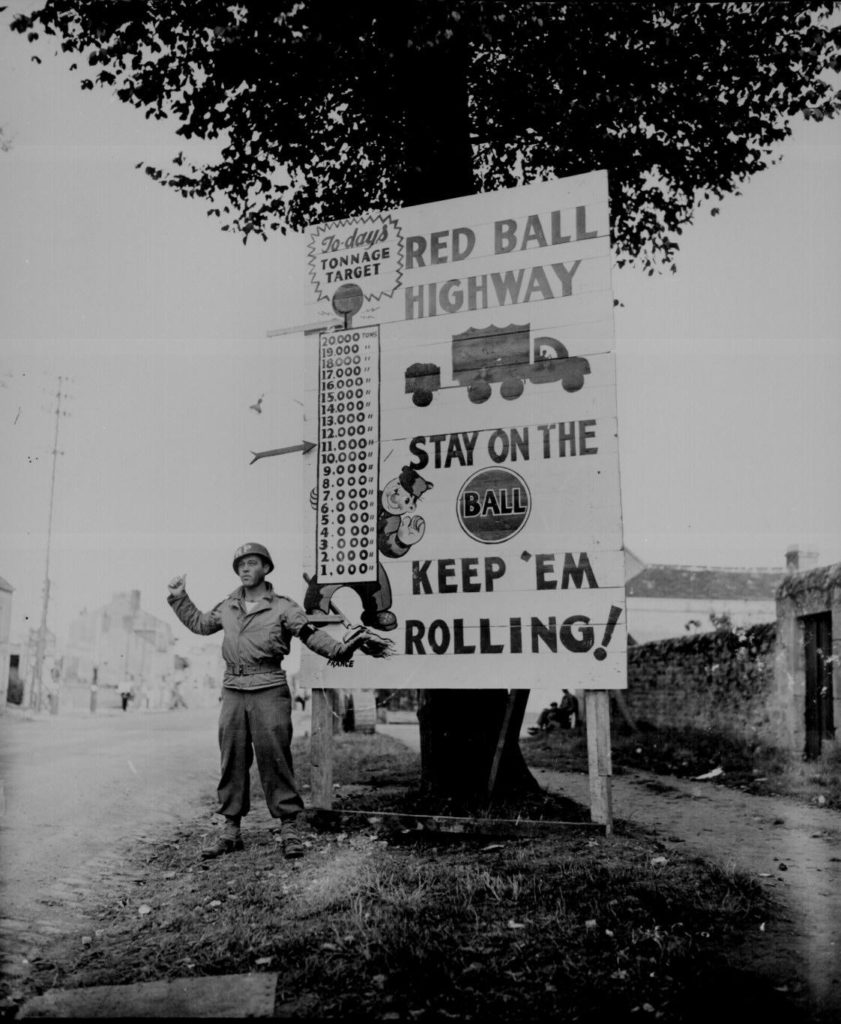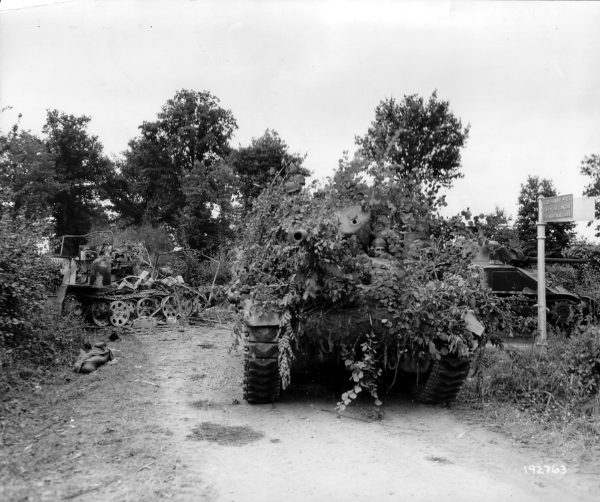The importance of logistics
As the month of August comes to an end, the 9th Infantry Division had once again proved its efficiency and flexibility in the race against time that was imposed on VII Corps. The division’s organic Combat Teams had moved from eastern Normandy to the Belgian border in less than ten days, crossing the Seine, Marne and Aisne rivers without incident. The soldiers on the front line had had no decent respite since the fighting began in mid-June 1944 (the first elements landed on Utah Beach on 10 June). As the Normandy campaign was ending, they were asked to take on a new challenge, that of accomplishing a military feat never before achieved.

Abstract of the map « The Route of the Ninth Division through the NATOUSA & ETOUSA ; Nov. 8th, 1942 – Aug. 1945 » prepared by the Division G-3 Section (1945)
This feat could not have been accomplished without the support and logistical units – in particular the 9th Signal Company, 709th Ordnance Company and the 9th Quartermaster Company . The rapid advance of the VII Corps – and the 9th Infantry Division – completely transformed the face of the front. While the Normandy fighting imposed a front line deployment, the race inland created a movement in depth, therefore stretching the lines of communication and supply. By the end of August, the fighting units were hardly stopped or slowed down by the enemy and continued to rush towards Belgium while the logistics did not keep up with the infernal pace.
The 9th Signal Company did an exemplary job during this crazy week. The composition of a Signal Company did not allow them to advance as quickly as the line companies. Moreover, the men of the Signal Company were spread throughout the units of the division. Telephone line laying, dispatchers, radio technicians… a multitude of specialties existed to enable the whole division to communicate. Such a rapid and unexpected surge inevitably meant more work, more lines, more powerful frequencies; and therefore more damage, more interventions, more repairs. The technicians of the 9th Signal Company did an incredible job keeping the lines open 24 hours a day, seven days a week.

The 709th Ordnance Company was a company of mechanics and armorers, responsible for the maintenance operations of weapons and vehicles. Their mission was to ensure that the vehicles and weapons never stopped rolling or firing. Parts breakage, wear and tear, and the extreme conditions under which the equipment was treated required exponential work from this company of technicians. The front line was moving faster than the logistics, and the Ordnance was unable to get parts from local shops. Mechanics were forced to work along roads and tracks, or in small villages in makeshift workshops. Without the 709th Ordnance Company, the division would simply not have been able to carry out the missions assigned to it by VII Corps, and reach the Belgian border so quickly.

These GIs are from the 514th Quartermaster Truck Regiment. Their role was to bring all supplies to the various Quartermaster companies of the divisions, including the 9th Quartermaster Company. Rations, ammunition, gas, water; everything was transported in the impressive trucks which never stopped. The 514th QM Truck Regiment supplied the First and Third Armies during the advance into Northern France.
(© U.S. Army Signal Corps – National Archives)
An American infantry division had about fourteen thousand men. We can estimate that the 9th Infantry Division at the end of August could count between nine and eleven thousand men, after the fighting in Normandy. That is as many men to feed three times a day, and to supply with water, ammunition and clean clothes; and as many vehicles that consume petrol. This difficult and thankless task fell to the 9th Quartermaster Company. Stocks and depots were far to the rear, and these supplies had to be brought to the front line, without which men, weapons and vehicles could not operate, and with the ground gained, the supply routes became longer with each journey. One of the enemy’s greatest mistakes was to underestimate the ability of the American army to keep its troops moving continuously, without stopping. And this ‘spin’ was only possible because of the support and logistical units, whose exceptional work surprised many enemy soldiers and saved many American lives.

A retreating German army
On 17 August 1944, Field Marshal Walter Model replaced Gunther Von Kluge as head of Heeresgruppe B, which at that time comprised the 1. Armee, 5. Panzerarmee, 7. Armee, 15. Armee and the reserve stationed in the Netherlands. The Falaise Pocket had caused a considerable weakening of the German armed forces in the west. Combined with the Allied landings in southern France, the Allied operations only increased the confusion that already existed within the German armies and the high command in Germany. The corps and divisions that were retreating from Normandy were no longer a coherent force, but a multitude of fighting groups fleeing the front in disarray, under-equipped and poorly armed, unable to stand up to the Allied war machine. In Germany, Hitler continued to reinforce the armies of the west, reluctantly distorting the forces opposed to the Russian army, which was also gaining ground. The success of the German retreat across the Seine depended more on the ability of the Anglo-Americans to supply themselves with petrol, rather than the Germans themselves.
Generals Hans Von Kluge (left) and Walter Model (right) together during the Battle of Kursk, August 1943.
(© Bundeswehr Archives)

On 1 September, the 9th Infantry Division faced the German 1. Armee, commanded by General Kurt von der Chevallerie. The 1. Armee actually included all units present in its area of responsibility, and among them the 1. SS-Panzer-Division « Leibstandarte SS Adolf Hitler », the 12. SS-Panzer-Division « Hitlerjugend » and the 2. SS-Panzer-Division « Das Reich », three SS divisions infamous for their earlier massacres. These three SS units were the main forces opposing General Louis A. Craig’s 9th Infantry Division, often reinforced with regiments found here and there to form better organised tactical battle groups. Although heavily weakened by the long and violent fighting in Normandy, these SS divisions had unrivaled combat experience and a particular knowledge of the terrain, since Belgium had been for most of them, a rest area or a maneuvering ground.

26 July 1944 in Normandy, SS-Sturmbannführer Erich Olboeter (Commanding Officer of the III. /26. SS-PzGrRgt.), SS-Standartenführer Kurt Meyer (Commanding Officer of the 12. SS-PzDiv.) and SS-Standartenführer Wilhelm Mohnke (Commanding Officer of the 26. SS-PzGrRgt.) after a presentation of medals. All three are wearing effects made of Italian camouflage canvas model M29.
(© Private collection)
On 30 August, the unexpected breakthrough of the 39th and 47th Regimental Combat Teams forced the German units to reorganize, and the experienced SS units were given the task of delaying the First U.S. Army, allowing the rest of its forces to withdraw behind the Siegfried Line to reorganize the Reich’s defense. The orders are to create several battle groups around tactical points. Two Kampfgruppen of the 1. and 12. SS-PzDiv. were deployed in the Serre River sector, around Marle (1. SS-PzDiv.), around Montcornet (I. Battalion, SS-Panzer-Grenadier-Regiment 25, 12. SS-PzDiv.) and around Rozoy-sur-Serre (III. Battalion, SS-Panzer-Grenadier-Regiment 26, 12. SS-PzDiv.) These two Kampfgruppen were attached to the II. SS-Panzerkorps. At Brunehamel, a company of Fliegerregiment 22 arrived from Laon airfield to redeploy along the defense line described above. The left flank was to be defended by units of the 2. SS-PzDiv. at the request of SS-Obergruppenführer Wilhelm Bittrich commanding the II. SS-Panzerkorps, but no contact could be established between the units of the Hitlerjugend and the Das Reich, whose area of responsibility had been located around Rethel.

Locations of the main Kampfgruppen facing the 9th Infantry Division on 30 August 1944, France.


Comments are closed